Diplomatic Bluebook 2017
Chapter 2
Japan's Foreign Policy that Takes a Panoramic Perspective of the World Map
3.Southeast Asia
(1) Indonesia
The Joko administration inaugurated in October 2014 has so far increased its support from the people by implementing two cabinet reshuffles, reforms of the social welfare system, reforms of the education system and other economic policies, and the administration is further increasing stability. On the other hand, as can be seen in the large-scale demonstrations and crowds on November 4 and December 2, 2016, each of the political forces are stepping up their activities as the February 2017 Jakarta gubernatorial election approached.
In relations with Japan, meetings between the leaders and ministers were held following the previous year and relations with the Joko administration were strengthened. President Joko, who visited Japan for the outreach meeting for the G7 Ise-Shima Summit in May, held a conversation with Prime Minister Abe and confirmed that both would proceed with cooperation in the infrastructure area, etc. Furthermore, on the occasion of the UN General Assembly in September, Foreign Minister Kishida held a meeting with Foreign Minister Retno and they shared the view that they would further strengthen their “strategic partnership” and to cooperate with each other in bilateral relations in addition to regional issues such as the South China Sea, North Korea, etc.
In December, Coordinating Minister for Maritime Affairs Luhut visited Japan and signed the Memorandum of Cooperation with Foreign Minister Kishida to set up the Japan-Indonesia Maritime Forum for encouraging cooperation in the maritime area between Japan and Indonesia going forward both as maritime nations.
Also in December, Japan provided emergency relief goods (500 tents worth 6,600,000 yen) to Indonesia, through the Japan International Cooperation Agency (JICA) following serious damage from the earthquake disaster in Aceh.
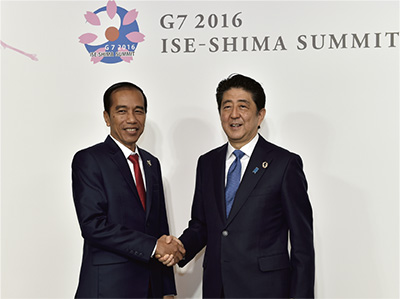 Prime Minister Abe shaking hands with President Joko of Indonesia visiting Japan for the outreach meeting for the G7 Ise-Shima Summit (May 27, Mie Prefecture).
Prime Minister Abe shaking hands with President Joko of Indonesia visiting Japan for the outreach meeting for the G7 Ise-Shima Summit (May 27, Mie Prefecture).(2) Cambodia
Cambodia is located in a strategic point of the Southern Economic Corridor and serves as a key country in strengthening connectivity and narrowing regional development gap in the Mekong region. The country has been promoting a development policy with emphasis on the enhancement of governance, with the aim of entering the group of Upper Middle-Income Countries in 2030.
Japan has been cooperating actively with Cambodia, including through the Cambodian peace process in the late 1980s and in its subsequent reconstruction and development process. In 2013 the relations between the two countries were elevated to a “strategic partnership.” In 2016 taking the opportunity of the Asia-Europe Meeting (ASEM) Summit Meeting (in Mongolia), the Japan-Cambodia Summit Meeting was held. Prime Minister Abe stated that Japan would continue to support Cambodia through initiatives such as exporting quality infrastructure, strengthening Mekong connectivity and developing industrial human resources, and in response, Prime Minister Hun Sen once again expressed his support for Japan's policies for peace including Proactive Contribution to Peace and Legislation for Peace and Security. In addition from Cambodia, President of the Senate Say Chhum visited Japan in February upon invitation from Masaaki Yamazaki, President of the House of Councillors, and from Japan, Parliamentary Vice-Minister for Foreign Affairs Masakazu Hamachi visited Cambodia in March and Parliamentary Vice-Minister for Foreign Affairs Kiyoshi Odawara visited Cambodia in September.
In recent years, an expansion of the bilateral relationship has been seen in a variety of areas such as an increase in the number of Japanese residents and Japanese companies in Cambodia, and vitalized exchanges between local governments, etc. In May 2016, the Japan-Cambodia Air Services Agreement entered into force, and in September direct flights began operating between Narita and Phnom Penh.
Regarding domestic affairs, political discord between the ruling and opposition parties has continued since the opposition party became much stronger in the National Assembly (lower house) election in 2013, and in 2016 tensions rose as judicial proceedings were conducted against leading figures from the opposition party and people involved in civil society. Trends going forward are being closely watched in the run-up to the local elections in 2017 and the general elections in 2018.
In the Khmer Rouge Trials which Japan has been supporting for many years, two former leaders of the Khmer Rouge regime, including a former head of state, were given sentences of life imprisonment by the Supreme Court Chamber in November 2016.
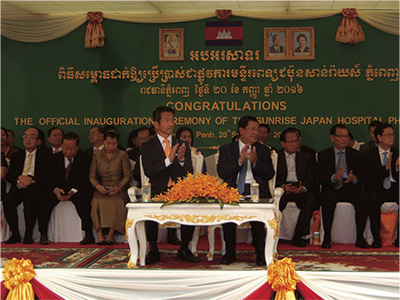 Parliamentary Vice-Minister for Foreign Affairs Odawara attending the Official Inauguration Ceremony of the Sunrise Japan Hospital (September 20, Phnom Penh, Cambodia).
Parliamentary Vice-Minister for Foreign Affairs Odawara attending the Official Inauguration Ceremony of the Sunrise Japan Hospital (September 20, Phnom Penh, Cambodia).(3) Singapore
2016 is the 50th anniversary of the establishment of diplomatic relations between Japan and Singapore, and a variety of commemorative projects were successfully held in the two countries, deepening the friendly relationships between the people of the two countries. Furthermore, there were even more visits by dignitaries to the two countries than in 2015.
In April, Minister for Foreign Affairs Balakrishnan came to Japan and on April 26, the day on which diplomatic relations were established between the two countries 50 years ago, he held a Foreign Ministers' Meeting with Foreign Minister Kishida, and they confirmed that they would further strengthen cooperation not only in bilateral relations but also regarding the regional and international situation.
On the economic front, a number of Japanese companies have established regional headquarters in Singapore, and cooperation between companies from the two countries continues to progress in the area such as infrastructure. Furthermore, the two countries work together to actively carry out technical cooperation as well as intellectual and cultural exchanges targeting developing countries through the “Japan-Singapore Partnership Program 21 (JSPP21).”
Furthermore, when Prime Minister Abe and Foreign Minister Kishida stopped over in Singapore in August en route to Kenya to attend the Sixth Tokyo International Conference on African Development (TICAD VI), they made a call of condolence to former president S.R. Nathan who had passed away the same month.
When Prime Minister Lee Hsien Loong visited Japan in September, a summit meeting was held and Prime Minister Abe presented Prime Minister Lee the Grand Cordon of the Order of the Paulownia Flowers, which was conferred upon the former prime minister Lee Kwan Yew who passed away in 2015, and also confirmed further strengthening of cooperation between the two countries.
From November to December, President Tan and his spouse paid a State Visit to Japan and held a summit meeting with Prime Minister Abe.
 Official logo for the 50th anniversary of the establishment of Japan-Singapore diplomatic relations
Official logo for the 50th anniversary of the establishment of Japan-Singapore diplomatic relations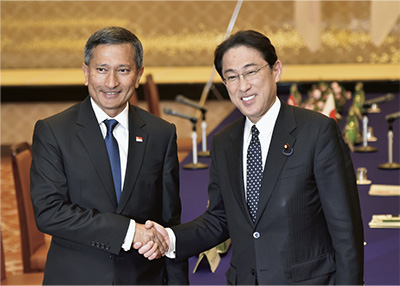 Foreign Minister Kishida shaking hands with Minister for Foreign Affairs Balakrishnan of Singapore (April 26, Tokyo).
Foreign Minister Kishida shaking hands with Minister for Foreign Affairs Balakrishnan of Singapore (April 26, Tokyo).(4) Thailand
Thailand is located in the center of the Mekong region. There exists a “strategic partnership” relationship between Japan and Thailand. A lot of production bases of Japanese companies are in Thailand as a consequence of investment accumulated over the years. Nowadays, they serve as an essential part of supply chains on a global scale for the Japanese economy.
After the coup led by the military in May 2014, under the parliament and interim cabinet established by the military government, a process to restore democracy has been under way. A new draft constitution was approved in a national referendum held in August 2016, and going forward Thailand plans to undertake the necessary procedures to promulgate the constitution. It is not likely before the end of 2017 that democracy will be restored through the implementation of parliamentary elections.
As a consequence of the demise on October 13, 2016 of His Majesty King Bhumibol, who was loved and respected as figure of spiritual support for the people and led the development of Thailand over the course of a long reign of 70 years since acceding to the throne in 1946, the new king, His Majesty King Vajiralongkorn, acceded to the throne on the same day (the announcement of the accession was on December 1).
Various levels of exchanges, including political and economic, have been carried out between Japan and Thailand on the foundation of the close relationship between the imperial and royal families. In May 2016, Foreign Minister Kishida implemented his first bilateral visit to Thailand since he took office. During this visit, a wide-ranging exchange of views regarding bilateral relations, the regional affairs, etc., was held, and in addition, the Memorandum of Intent on deepening the cooperation in agriculture and its related areas was signed. Furthermore, in July on the occasion of the ASEAN-related Foreign Ministers' Meetings (in Laos) Minister Kishida held a bilateral Foreign Ministers' meeting. In September, the President of the National Legislative Assembly Pornpet visited Japan and paid courtesy calls on the President of the House of Councillors and the Speaker of the House of Representatives of Japan. Moreover, in December the second meeting of the high-level joint committee was held, and an exchange of views regarding various points related to the economic relations between the two countries was held.
(5) Timor-Leste
Timor-Leste, as the first independent country of the 21st century, has realized peace and stability with the support of the international community and is building the nation based on democracy under President Ruak elected in 2012 and Prime Minister Araujo appointed in 2015. In July 2011, a “Strategic Development Plan (SDP)” (long-term guidelines for development policy up until 2030) was formulated, and the country is currently proceeding from the stage of post-conflict reconstruction to the new stage of full-scale development. Japan will continue to fully boost the efforts of Timor-Leste as it proceeds to this new stage, while continuously maintaining close cooperation in the international arena. Furthermore, Japan supports Timor-Leste's targeted policy of acceding to ASEAN smoothly and assists in human resources development toward the accession.
In March 2016, President Ruak paid a Working Visit to Japan to hold the Japan-Timor-Leste Summit Meeting with Prime Minister Abe and they issued the joint press release on the “Evolved Partnership for Growth and Development” and agreed to develop the relations between the two countries from “cooperative relations in the period of reconstruction after conflict” to “cooperative relations in an era of growth and development.” Vigorous high-level exchanges are continuing. For example, in June Minister of Defense Gen Nakatani visited Timor-Leste and in October, Minister of Planning and Strategic Investment Gusmão came to Japan.
(6) The Philippines
In the Philippines, the term of office of President Benigno Aquino came to an end, and as a result of the May 2016 presidential election, the new Duterte administration was inaugurated. President Duterte contributed to improving law and order in Davao City when he was the mayor of Davao, and after his inauguration as president, he established measures to combat illegal drugs as an important issue for his administration and has been strengthening the crackdown on drugs. Regarding peace in Mindanao, he is working on the implementation of the comprehensive peace agreement agreed by the previous Aquino administration and is aiming to introduce a federal system to the Philippines. Regarding the economy, in recent years the Philippines has been maintaining strong economic growth. The Duterte administration has continued the macroeconomic policies of the Aquino administration and is working on tax reforms, infrastructure development, etc., under 10-point socioeconomic agenda.
In relations with Japan, 2016 marked the 60th anniversary of the normalization of diplomatic relations between Japan and the Philippines. Regarding relations with the new Duterte administration, Foreign Minister Kishida visited Davao City, the hometown of President Duterte, in August and held a meeting with the president and Foreign Secretary Yasay. Furthermore, in October, President Duterte paid an Official Visit to Japan and held a summit meeting with Prime Minister Abe. Prime Minister Abe stated that Japan would continue to support the initiatives of President Duterte, including building the maritime capacity of the Philippines, peace in Mindanao, infrastructure development, etc., and the leaders confirmed that they would further strengthen the “strategic partnership” of the two countries in a wide range of areas.
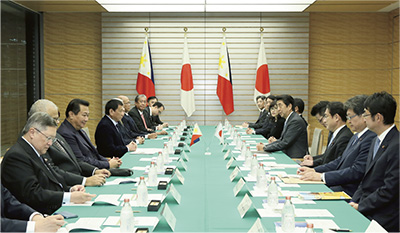 Japan-Philippines Summit Meeting (October 26, Tokyo; Photo: Cabinet Public Relations Office)
Japan-Philippines Summit Meeting (October 26, Tokyo; Photo: Cabinet Public Relations Office)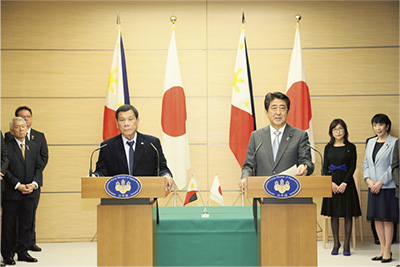 Joint press announcement by the leaders of Japan and the Philippines (October 26, Tokyo Photo: Cabinet Public Relations Office)
Joint press announcement by the leaders of Japan and the Philippines (October 26, Tokyo Photo: Cabinet Public Relations Office)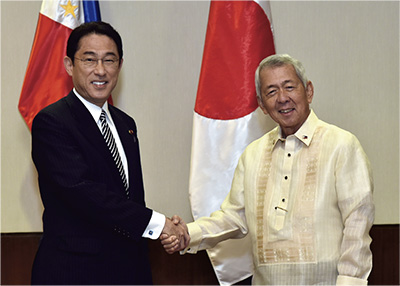 Japan-Philippines Foreign Ministers' Meeting (August 11, Davao, Philippines).
Japan-Philippines Foreign Ministers' Meeting (August 11, Davao, Philippines).(7) Brunei
Brunei was achieving high economic levels and excellent social welfare, thanks to rich natural resources. However, the economic growth rate has fallen in the past few years, caused by falling prices of crude oil and natural gas so the Government of Brunei is aiming for the diversification of industry.
Japan and Brunei have maintained a good relationship based on the foundation of a stable supply of liquefied natural gas (LNG) that has been continuing for many years. Japan intends to actively contribute to industry diversification, in which Brunei is making efforts. Based on that thinking, Japan supports Brunei officials training in Japan. Furthermore, Brunei has been serving as the ASEAN's Country Coordinator for Japan for three years since August 2015.
In relations with Japan, high-level exchanges were held vigorously following the previous year. Foreign Minister Kishida held meetings with Second Minister of Foreign Affairs and Trade Lim Jock Seng in January (in Tokyo), July (in Laos), and November (in Peru), and they confirmed that they would strengthen bilateral relations and cooperate closely toward further development of Japan-ASEAN relations.
In June, measures restricting imports of food products from Japan after the Great East Japan Earthquake were partially eased in Brunei. Japan is continuing to call upon Brunei to lift the remaining restrictions as soon as possible.
Furthermore, there are many cultural and people-to-people exchanges, including sports exchanges. For example, in October a Japan-Brunei badminton exchange commemorating the 70th birthday of Sultan Bolkiah was carried out and from Japan, a total of seven people including the Nippon Badminton Association, the coach, and the national team members visited Brunei to hold a badminton tournament and practice matches with Bruneian badminton players and the general public, etc.
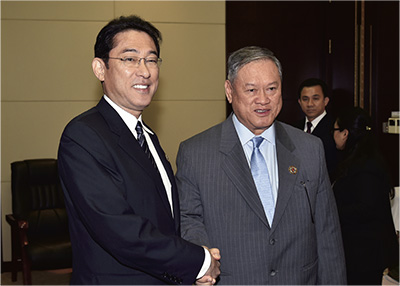 Foreign Minister Kishida shaking hands with Minister at the Prime Minister's Office and Second Minister of Foreign Affairs and Trade Lim Jock Seng (July 25, Vientiane, Laos).
Foreign Minister Kishida shaking hands with Minister at the Prime Minister's Office and Second Minister of Foreign Affairs and Trade Lim Jock Seng (July 25, Vientiane, Laos).(8) Viet Nam
Located next to sea lanes in the South China Sea and having a long border line with China, Viet Nam is a geopolitically important country. Given that the country embraces the 3rd largest population in Southeast Asia, and experiencing a surge in the number of those in middle-income brackets, Viet Nam is becoming a promising market. While the economy slowed down from the late 2000s, it is on a recovery trend in recent years thanks to efforts of macro-economic stabilization such as curbing inflation, and foreign investment promotion through the development of infrastructure and improvement of the investment environment. Furthermore, the country is working on a reform of the financial sector and state-owned enterprises and participated in the Trans Pacific Partnership (TPP) agreement to diversify the economy, etc.
With regard to domestic affairs, the National Congress of the Communist Party of Viet Nam (CPV), organized every five years, was convened in January 2016. General Secretary Trong was re-elected, and the new leadership of the Party was inaugurated. At the National Assembly convened from around March to April, President Quang (the head of state) and the Prime Minister Phuc were newly elected. However, in Viet Nam, which adopts a collective leadership, a significant change in policy on domestic and external affairs is unlikely to happen. Note that in recent years, awareness about the importance of incorporating democratic elements is gradually increasing even under the one-party leadership, as seen by the fact that a vote of confidence is implemented for the ministers in the national assembly and for the Politburo and the Secretariat members in the Communist Party.
In response to the situation in which China continues land reclamation and the construction of outposts in the Spratly Islands, etc., Viet Nam is seen to have a sense of vigilance against China over the situation in the South China Sea. In terms of relations with the U.S., the relationship is developing, as U.S. President Obama visited Viet Nam in May and announced the full lifting of the arms embargo on Viet Nam, etc.
Japan is the largest donor of Official Development Assistance (ODA) and the second largest investor country for Viet Nam. Japan-Viet Nam relations have been progressing in a wide range of fields, such as economic cooperation, security, and cultural exchange, based on the “Extensive Strategic Partnership.” Mutual high-level exchanges and VIP visits are continuing, including the following: Prime Minister Abe held a summit meeting in the Prime Minister's Office with Prime Minister Phuc, who came to Japan to attend the outreach meeting for the G7 Ise-Shima Summit in May, and held further meetings with him on the occasion of the ASEM Summit (in Mongolia) in July and the ASEAN-related Summit Meetings (in Laos) in September, and in addition, on the occasion of the APEC Economic Leaders' Meeting in Peru in November, he held a meeting with President Quang.
(9) Malaysia
The Najib administration has been steadily implementing a “new economic model,” a “government transformation program,” and an “economic transformation program” under the slogan of “One Malaysia (nation first, prompt execution).” All of these programs were announced in 2010 to facilitate ethnic reconciliation, the enhancement of administrative reform, and the improvement of public welfare. Furthermore, in 2015 it announced the “11th Malaysia Plan (a five-year plan from 2016 to 2020),” and the country, with the aim to enter the group of advanced countries by 2020, proceeds with deregulation and liberalization to strengthen international competitiveness while maintaining a steady growth at home, supported by investment and domestic consumption.
Concerning its relationship with Japan, many visits of VIPs were implemented again in 2016. In May 2016, Deputy Prime Minister and Minister of Home Affairs Dato' Seri Dr. Ahmad Zahid Hamidi visited Japan and paid a courtesy call on Prime Minister Abe, and in addition, held meetings with Deputy Prime Minister and Finance Minister Taro Aso and Foreign Minister Kishida in which it was confirmed they would further develop the bilateral relations. Furthermore, in July in New York, Foreign Minister Kishida held a meeting with Minister of Foreign Affairs Dato' Sri Anifah bin Aman and they confirmed they would cooperate closely on issues in the region and the international community as fellow UN Security Council members from Asia. At the summit meeting in November when Prime Minister Najib visited Japan, the two leaders shared the view that they would further strengthen bilateral cooperation based on their “strategic partnership” toward 2017, the 60th anniversary of the establishment of diplomatic relations.
On the economic front, close cooperation continues, as shown by the fact that Japan is the largest investor for Malaysia and the number of Japanese-affiliated companies operating in Malaysia amounts to as many as 1,400.
The Look East Policy, which serves as a foundation for the good bilateral relationship, celebrated its 30th anniversary in 2012. In this program, about 15,000 people have studied or have been trained in Japan so far. Currently, Malaysia is considering a program referred to as “Look East Policy 2.0” to expand and improve the quality of the Look East Policy. The two countries are cooperating in making the Malaysia Japan International Institute of Technology (MJIIT), which was opened in September 2011, a base for Japanese-style engineering education in ASEAN. The possibility of cooperation is also being studied in a high-speed railway project between Malaysia and Singapore.
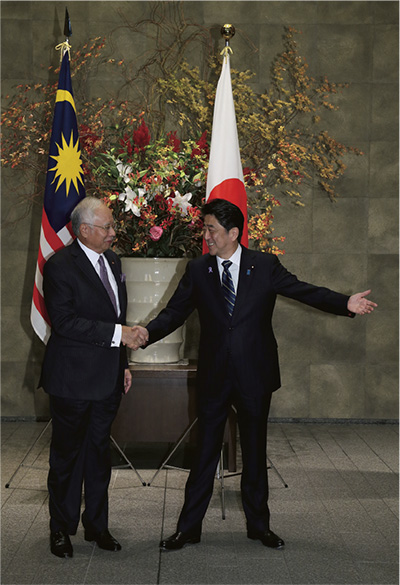 Prime Minister Abe greeting Prime Minister Najib of Malaysia (November 16, Tokyo; Photo: Cabinet Public Relations Office)
Prime Minister Abe greeting Prime Minister Najib of Malaysia (November 16, Tokyo; Photo: Cabinet Public Relations Office)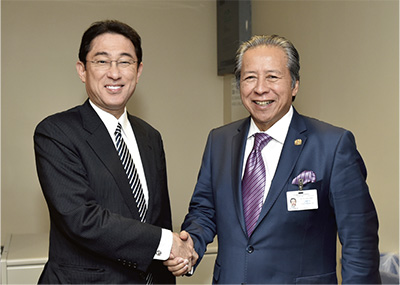 Japan-Malaysia Foreign Ministers' Meeting (July 28, New York, U.S.).
Japan-Malaysia Foreign Ministers' Meeting (July 28, New York, U.S.).(10) Myanmar
In Myanmar, in the general election in November 2015 the National League for Democracy (NLD), led by Aung San Suu Kyi, the leader of the movement for democratization, won a major victory and a new NLD government was inaugurated in late March 2016. Aung San Suu Kyi became the State Counsellor and Union Minister for Foreign Affairs and has established a position as the de facto top state leader, due to the constitutional hurdle which presents her from becoming a president. Htin Kyaw, who was her close aide for many years, was elected president by parliament.
The new administration is working on a cease-fire agreement with ethnic minority groups and the realization of domestic peace and national reconciliation. In addition to carefully maintaining relations with the armed forces, who still have strong political influence. Furthermore, it has announced new economic policies and has clarified policies oriented toward welcoming foreign investment as well as deregulation. On the diplomatic front, it is taking the stance of maintaining the conventional non-aligned neutrality while strengthening relations with neighboring countries.
The international community welcomed the inauguration of the first democratic administration in Myanmar for approximately half a century. With the recognition that the stability of the new administration is essential for the stability and prosperity of Myanmar and the region overall, Japan's policy intendeds to provide full-fledged support to Myanmar under the new regime and in cooperation with the government and private sectors. For example, Japan announced that its public and private sectors would contribute 800 billion yen over five years.
In November State Counsellor Aung San Suu Kyi visited Japan and held meetings with Prime Minister Abe and Foreign Minister Kishida respectively. Prime Minister Abe once again communicated the policy of full-fledged support in cooperation between the government and private sectors, and State Counsellor Aung San Suu Kyi stated that “Japan is a trustful partner” and expressed her expectations toward the support provided by Japan. Furthermore, wide-ranging consultations were held regarding cooperation measures for the economic development, peace, and stability of Myanmar, improvement of the investment environment and the regional situation, etc.
(11) Laos
Laos is a land locked country bordering the five countries of China, Myanmar, Thailand, Cambodia, and Viet Nam. The country is the key to the connectivity of the Mekong region. In recent years, Laos has been attracting more attention as an investment destination for Japanese companies, and economic exchanges including private sector investment have been becoming active. In May 2016, the Japan-Laos Air Services Agreement entered into force. The relations of the two countries have deepened in a wide range of areas, and the importance of Laos as a “strategic partner” of Japan is growing.
With regard to domestic affairs, 2016 was a year in which major political changes occurred. In January, the 10th Congress of the Lao People's Revolutionary Party was held where the appointment of the new party leadership was announced, and new General Secretary Bounnhang took office. The 8th National Parliamentary elections in March were held in conjunction with the restored provincial council elections, the first in 25 years. Following on from this, in April, the new leadership of the government was elected, General Secretary Bounnhang also became president, and Thongloun Sisoulith became the new prime minister.
In 2016, as Laos served as the chair country of ASEAN, its leadership in the international community attracted attention and many dignitaries visited Laos. Particularly notable was that President Obama visited Laos to attend the ASEAN-related Summit Meetings, marking the first visit by a U.S. President to Laos.
Regarding relations with Japan, immediately after his inauguration, Prime Minister Thongloun visited Japan in May in order to attend the outreach meeting at the G7 Ise-Shima Summit. In addition, Foreign Minister Kishida visited Laos in May and July (in July to attend the ASEAN-related Foreign Ministers' Meetings), and following that in September, Prime Minister Abe visited Laos to attend the ASEAN-related Summit Meetings. Therefore, the closest and most high-level exchanges were realized in the history of the two countries in 2016 alone, including the two summit meetings and three foreign ministers' meetings.
